Design and Optimization of SiON Ring Resonator-Based Biosensors for Aflatoxin M1 Detection
Abstract
:1. Introduction
2. Design and Simulation
| Wafer Name | SiON Refractive Index | Deposited Thickness (nm) | Expected Annealing Shrinkage (%) | After Annealing Estimated SiON Thickness (nm) |
|---|---|---|---|---|
| L2 | 1.66 | 410 | 15 | 349 |
| L5 | 1.8 | 240 | 10 | 216 |
2.1. Waveguide and Directional Coupler
2.2. Bending Radius and Ring Resonator Structures
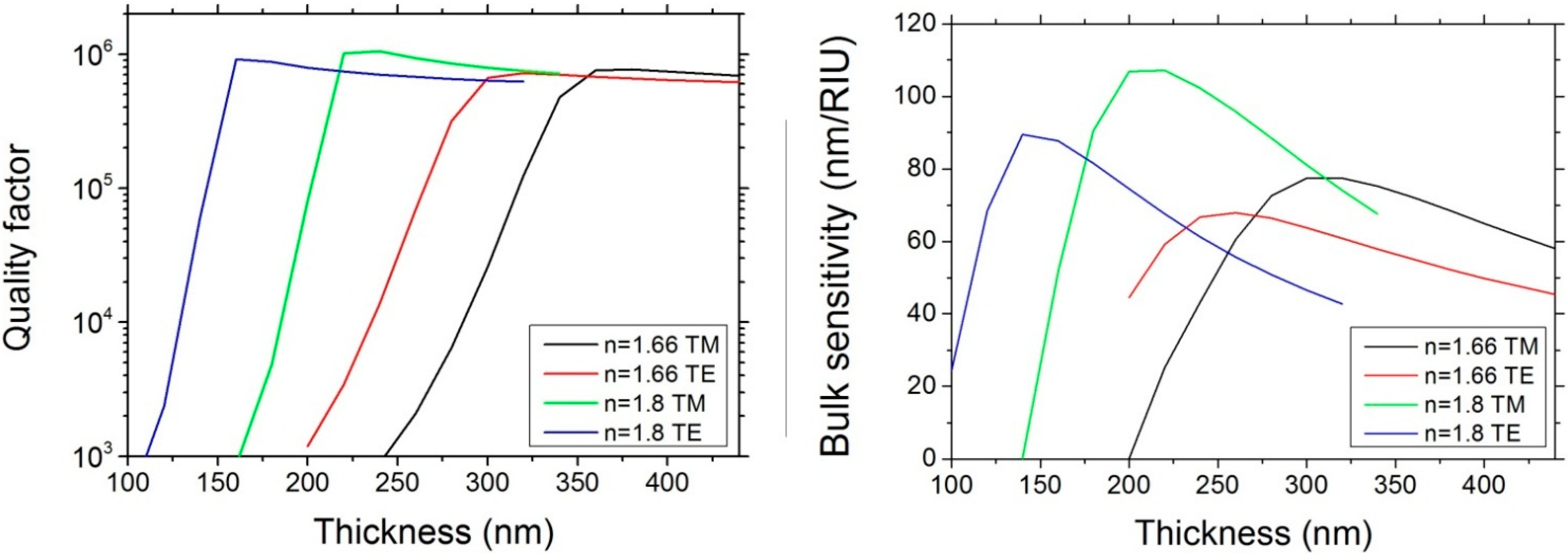

3. Experimental Characterization
3.1. Bending and Propagation Losses
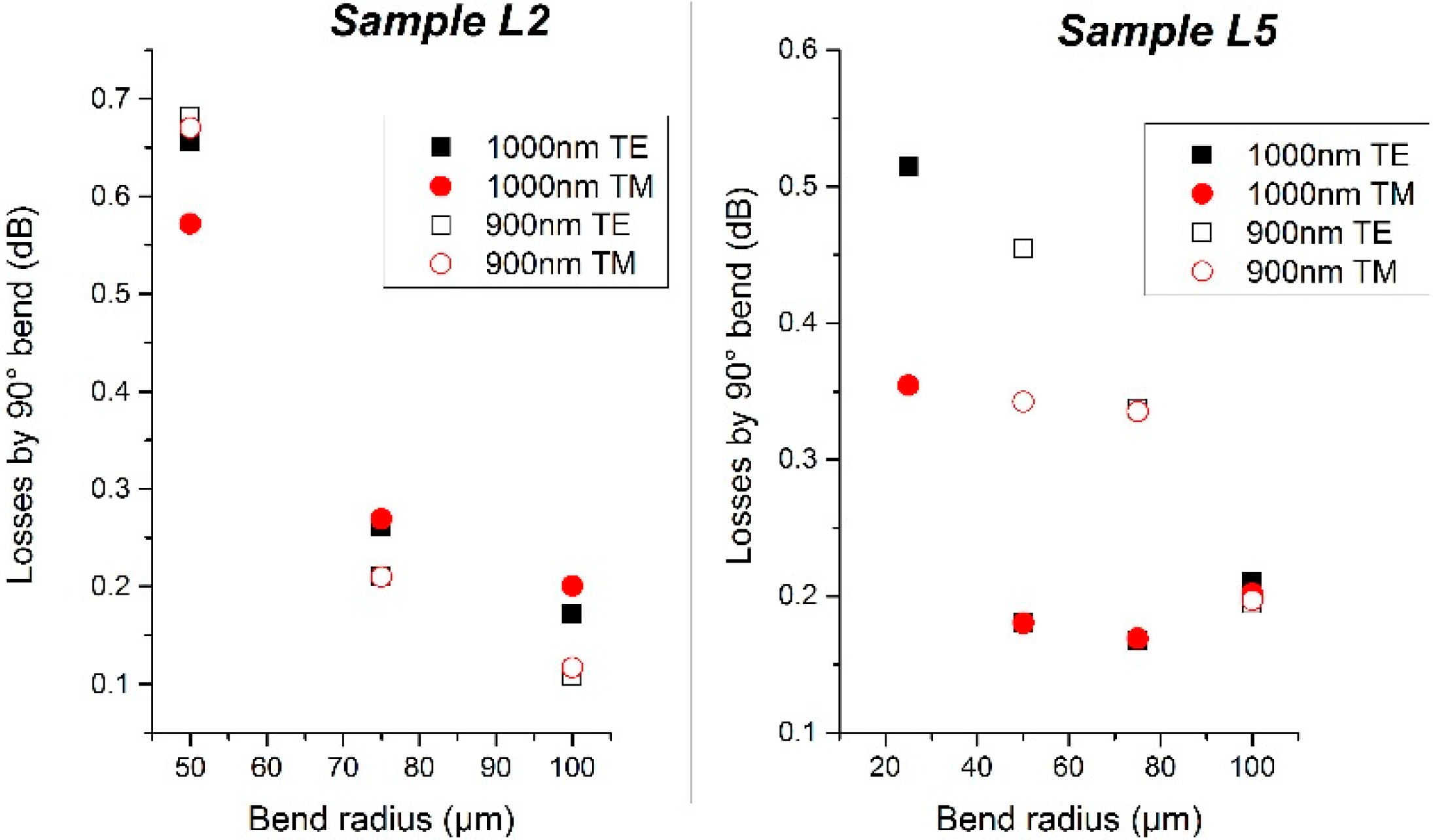
| Sample | Waveguide Width (nm) | Propagation Losses TE (dB/cm) | Propagation Losses TM (dB/cm) |
|---|---|---|---|
| L2 | 900 nm | 2.70 | 2.70 |
| 1000 nm | 0.87 | 1.00 | |
| L5 | 900 nm | 2.00 | 2.00 |
| 1000 nm | 0.61 | 0.70 |

3.2. Directional Coupler Characterization
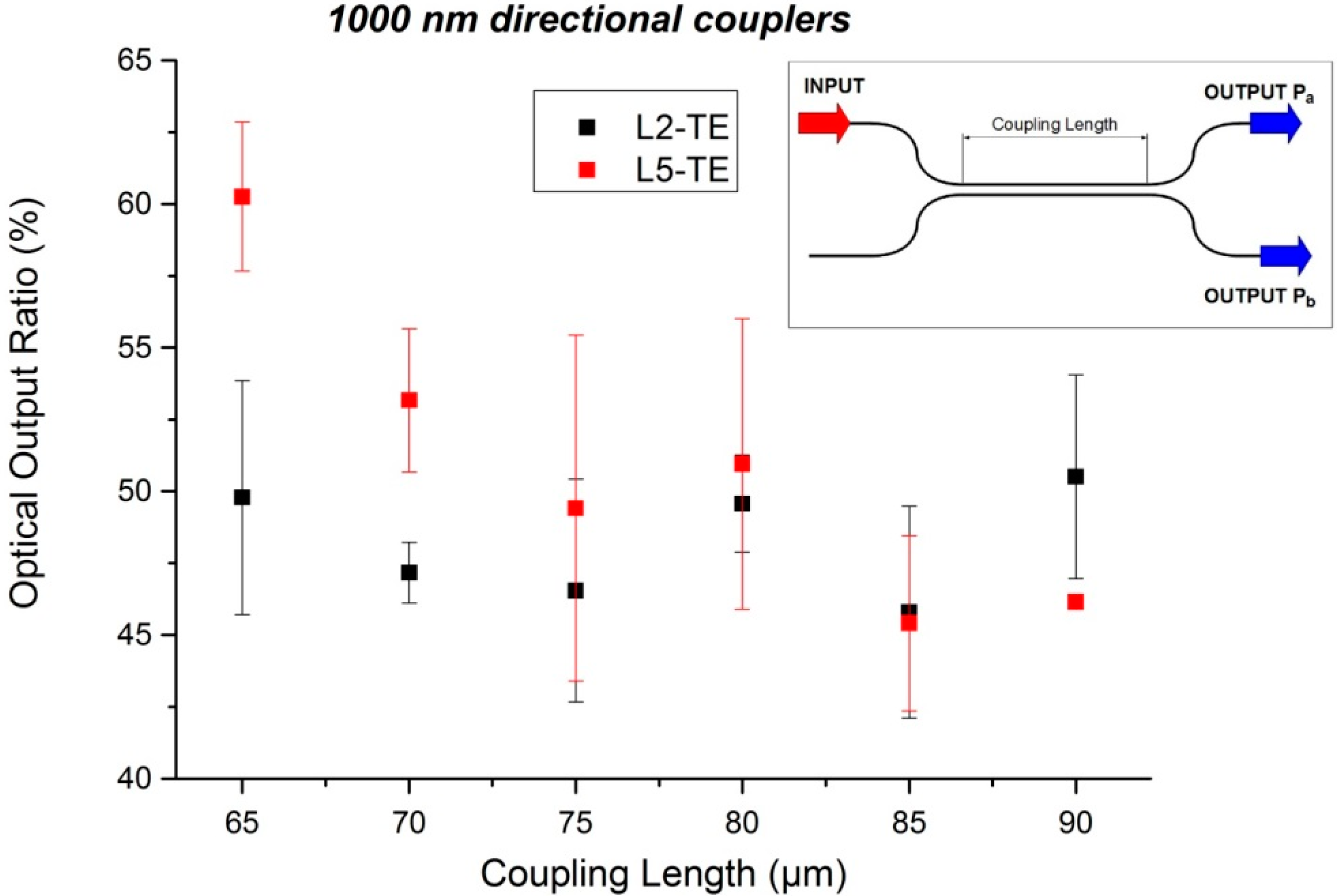
3.3. Ring Resonator Characterization
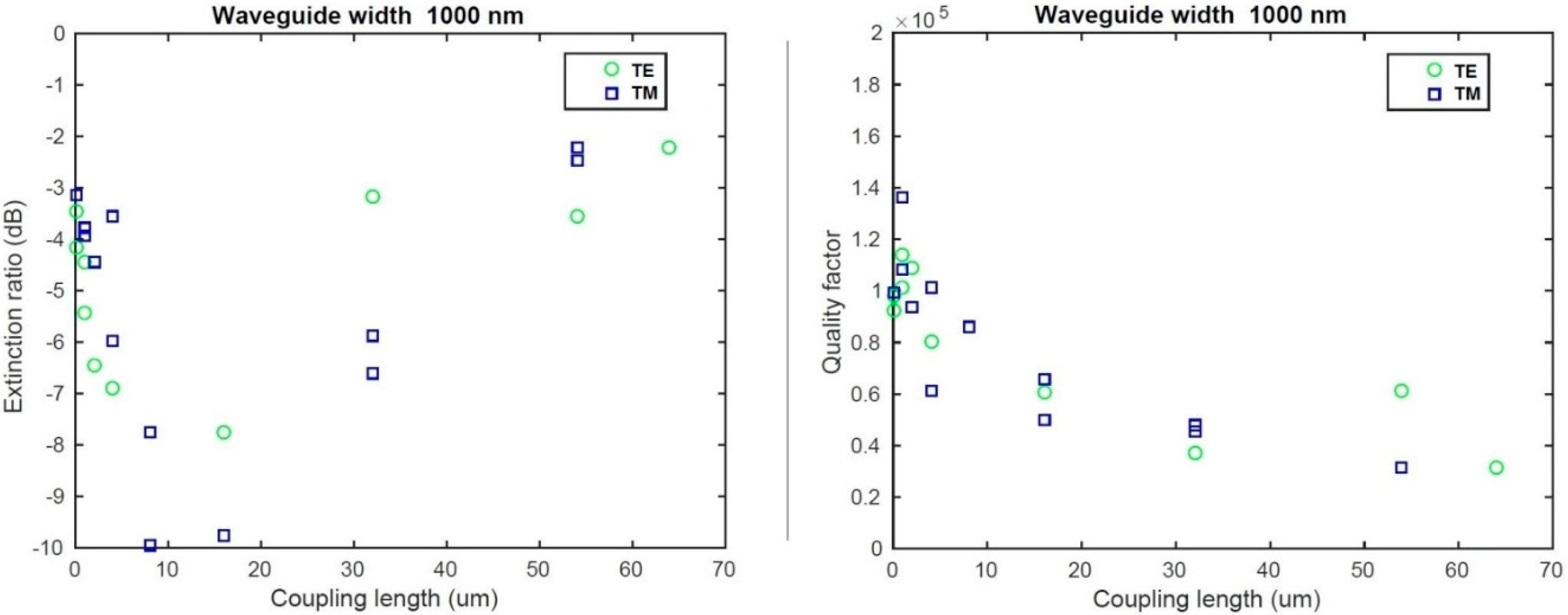

4. Sensitivity, Sensing Measurements, and Discussion
4.1. Sensitivity and Limit of Detection
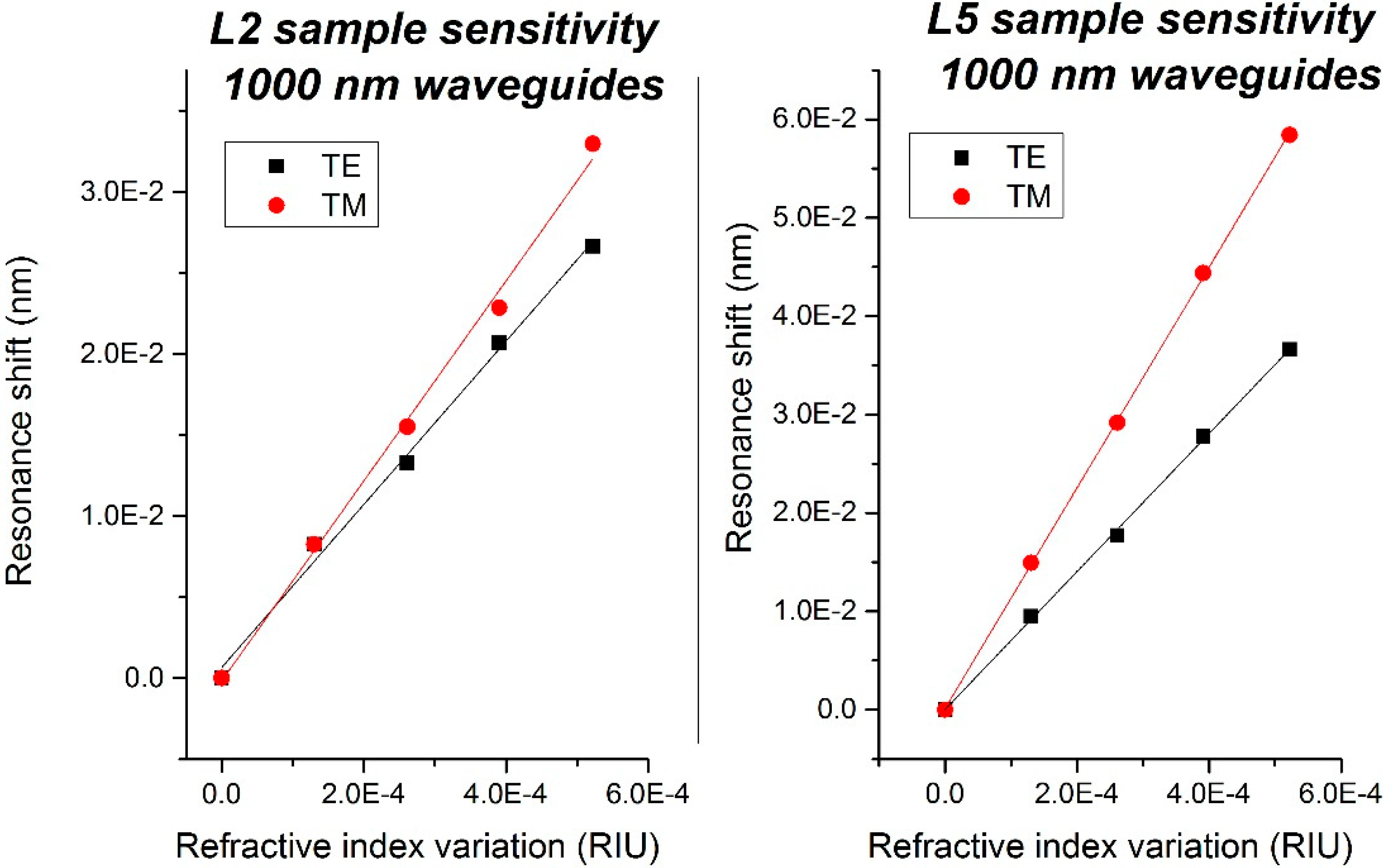
4.2. Aflatoxin-Sensing Measurements
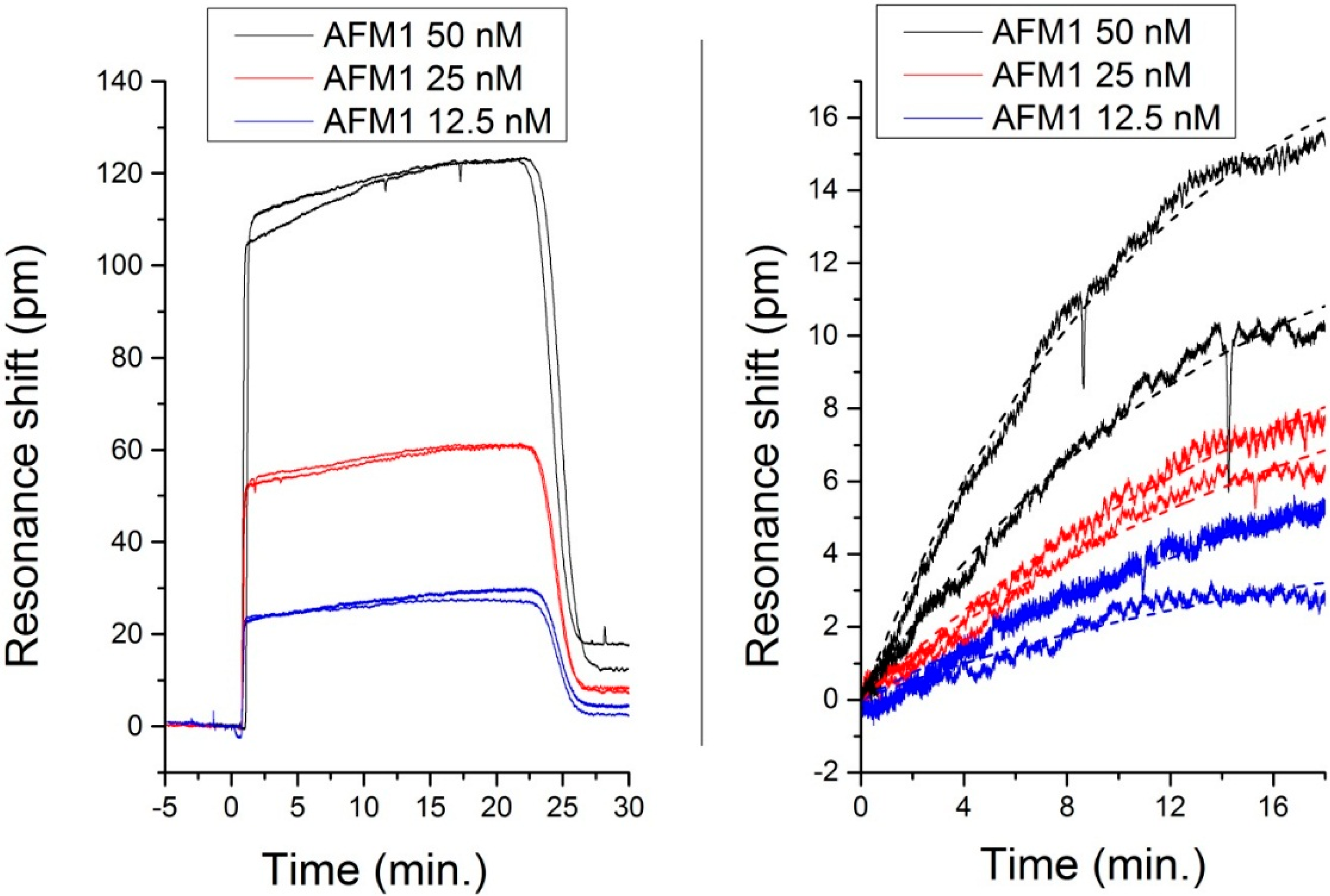
5. Conclusions
Acknowledgments
Author Contributions
Conflicts of Interest
References
- Ciminelli, C.; Campanella, C.M.; Dell’Olio, F.; Campanella, C.E.; Armenise, M.N. Label-free optical resonant sensors for biochemical applications. Prog. Quantum Electron. 2013, 37, 51–107. [Google Scholar] [CrossRef]
- Vollmer, F.; Yang, L. Label-free detection with high-Q microcavities: A review of biosensing mechanisms for integrated devices. Nanophotonics 2012, 1, 267–291. [Google Scholar] [CrossRef]
- Bogaerts, W.; de Heyn, P.; van Vaerenbergh, T.; de Vos, K.; Kumar Selvaraja, S.; Claes, T.; Dumon, P.; Bienstman, P.; van Tourhout, D.; Baets, R. Silicon microring resonators. Laser Photonics Rev. 2012, 6, 47–73. [Google Scholar] [CrossRef]
- Iqbal, M.; Gleeson, M.A.; Spaugh, B.; Tybor, F.; Gunn, W.G.; Hochberg, M.; Baehr-Jones, T.; Bailey, R.C.; Gunn, L.C. Label-free biosensor arrays based on silicon ring resonators and high-speed optical scanning instrumentation. IEEE J. Sel. Top. Quantum Electron. 2010, 16, 654–661. [Google Scholar] [CrossRef]
- Symphony Project Official Website. Available online: http://www.symphony-project.eu/ (accessed on 31 May 2015).
- COMSOL Multiphysics Modeling Software. Available online: http://www.comsol.com (accessed on 31 May 2015).
- Mancinelli, M. Linear and Nonlinear Coupling Effects in Sequence of Microresonators. Ph.D. Thesis, University of Trento, Trento, Italy, 2013. [Google Scholar]
- Cheema, M.I.; Kirk, A.G. Accurate determination of the quality factor and tunneling distance of axisymmetric resonators for biosensing applications. Opt. Express 2013, 21, 8724–8735. [Google Scholar] [CrossRef] [PubMed]
- Gandolfi, D.; Ramiro-Manzano, F.; Aparicio Rebollo, F.J.; Ghulinyan, M.; Pucker, G.; Pavesi, L. Role of edge inclination in an optical microdisk resonator for label-free sensing. Sensors 2015, 15, 4796–4809. [Google Scholar] [CrossRef] [PubMed]
- Guider, R.; Daldosso, N.; Pitanti, A.; Jordana, E.; Fedeli, J.-M.; Pavesi, L. Nano Si low loss horizontal slot waveguides coupled to high Q ring resonators. Opt. Express 2009, 17, 20762–20770. [Google Scholar] [CrossRef] [PubMed]
- Wörhoff, K.; Klein, E.; Hussein, G.; Driessen, A. Silicon oxynitride based photonics. In Proceedings of the 2008 10th Anniversary International Conference on Transparent Optical Networks, Athens, Greece, 22–26 June 2008.
- Yariv, A. Universal relations for coupling of optical power between microresonators and dielectric waveguides. Electron. Lett. 2000, 36, 321–322. [Google Scholar] [CrossRef]
- Gandolfi, D.; Guider, R.; Chalyan, T.; Pavesi, L.; Pasquardini, L.; Pederzolli, C.; Samusenko, A.; Pucker, G. Sensitivity and limit of detection of biosensors based on ring resonators. In Proceedings of the AISEM Annual Conference 2015 XVIII, Trento, Italy, 3–5 February 2015.
- Song, S.; Wang, L.; Li, J.; Zhao, J.; Fan, C. Aptamer-based biosensors. Trends Anal. Chem. 2008, 27, 108–117. [Google Scholar] [CrossRef]
- Palchetti, I.; Mascini, M. Electrochemical nanomaterial-based nucleic acid aptasensors. Anal. Bioanal. Chem. 2012, 402, 3103–3114. [Google Scholar] [CrossRef] [PubMed]
© 2015 by the authors; licensee MDPI, Basel, Switzerland. This article is an open access article distributed under the terms and conditions of the Creative Commons Attribution license (http://creativecommons.org/licenses/by/4.0/).
Share and Cite
Guider, R.; Gandolfi, D.; Chalyan, T.; Pasquardini, L.; Samusenko, A.; Pucker, G.; Pederzolli, C.; Pavesi, L. Design and Optimization of SiON Ring Resonator-Based Biosensors for Aflatoxin M1 Detection. Sensors 2015, 15, 17300-17312. https://doi.org/10.3390/s150717300
Guider R, Gandolfi D, Chalyan T, Pasquardini L, Samusenko A, Pucker G, Pederzolli C, Pavesi L. Design and Optimization of SiON Ring Resonator-Based Biosensors for Aflatoxin M1 Detection. Sensors. 2015; 15(7):17300-17312. https://doi.org/10.3390/s150717300
Chicago/Turabian StyleGuider, Romain, Davide Gandolfi, Tatevik Chalyan, Laura Pasquardini, Alina Samusenko, Georg Pucker, Cecilia Pederzolli, and Lorenzo Pavesi. 2015. "Design and Optimization of SiON Ring Resonator-Based Biosensors for Aflatoxin M1 Detection" Sensors 15, no. 7: 17300-17312. https://doi.org/10.3390/s150717300







